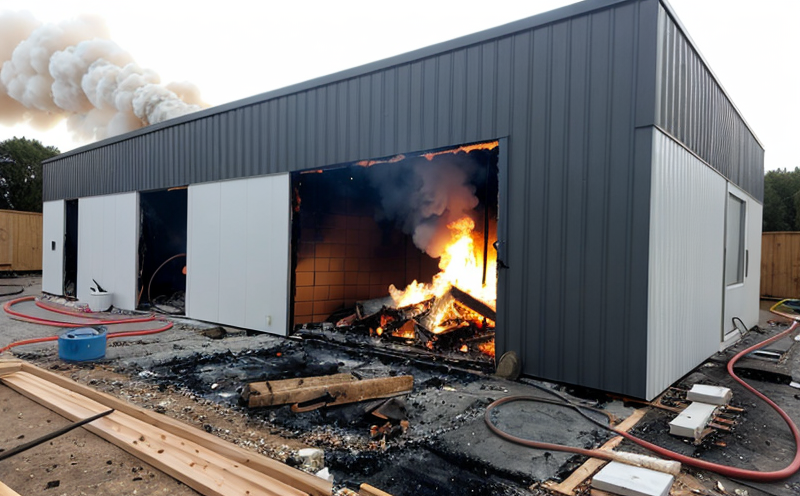EN 13501-2 Fire Resistance of Insulated Cladding Systems
The EN 13501-2 standard is a critical part of fire safety testing, particularly for insulated cladding systems used in building construction. This European standard specifies the methods to determine the fire resistance properties of these systems, ensuring that they meet stringent safety requirements. Insulated cladding plays a crucial role in both aesthetic and functional aspects of modern buildings, but its performance during a fire is paramount.
The standard applies to insulated metallic or non-metallic cladding materials used as external wall coverings on multi-storey buildings. It aims to establish the performance criteria for these systems under controlled laboratory conditions that simulate real-world scenarios where fires might occur. Compliance with this standard is essential for architects, engineers, and builders aiming to construct safe and compliant buildings.
The testing process involves subjecting a sample of the cladding system to intense heat and flame exposure. The objective is to evaluate how well the insulation and structural integrity hold up under these conditions, thereby assessing the potential risk of fire spreading from one part of the building to another. This includes analyzing the rate at which flames spread along the surface of the material as well as the amount of smoke produced.
The results obtained through this testing are critical for ensuring that buildings adhere to local and international fire safety regulations. They also provide valuable information for researchers and developers working on improving current technologies or developing new ones in this field.
Before delving into the specifics of EN 13501-2, it is important to understand why such testing is necessary. Building fires can be devastating events that not only cause property damage but also lead to loss of life if proper precautions are not taken during design and construction stages. By adhering to standards like EN 13501-2, architects and builders contribute significantly towards reducing these risks.
To summarize, the primary goal of EN 13501-2 is to ensure that insulated cladding systems perform reliably when subjected to fire conditions. This ensures not only compliance with regulatory requirements but also enhances public safety by preventing potential disasters from occurring due to insufficient materials or poor design practices.
Scope and Methodology
The scope of EN 13501-2 encompasses the testing procedures for determining the fire resistance properties of insulated cladding systems. According to Table 1 in this standard, several key parameters are considered during these tests:
| Parameter | Description |
|---|---|
| Flame Spread Index (FSI) | The ratio of the flame spread over time to the baseline value. |
| Smoke Production | The mass of smoke produced per unit area during testing. |
| Thermal Conductivity | The rate at which heat energy passes through a material. |
| Heat Release Rate (HRR) | The quantity of heat released by the specimen during combustion. |
These parameters are crucial in evaluating the overall fire performance of insulated cladding systems. During testing, specimens are exposed to a controlled environment where they are subjected to specific temperature and time intervals designed to mimic actual fire situations. The behavior of these specimens under such conditions provides valuable insights into their suitability for use in various architectural applications.
The methodology described in EN 13501-2 involves several steps that must be followed meticulously to ensure accurate results. These include:
- Selection and preparation of the test specimen
- Suspension or attachment of the specimen within the furnace
- Application of flame along the lengthwise axis of the sample
- Measurement of various parameters mentioned above during exposure to fire
It is essential that these procedures are carried out precisely as outlined in the standard to guarantee reliable and consistent outcomes. Any deviation could lead to inaccurate conclusions about the performance capabilities of the insulated cladding system being evaluated.
International Acceptance and Recognition
- Australia: The Australian Standard AS 1530.4-2008 aligns closely with EN 13501-2, ensuring compatibility between European Union countries and Australia.
- New Zealand: New Zealand's equivalent standard NZS 9229:2007 also follows the guidelines set forth by EN 13501-2.
- USA: Although not directly corresponding to this European standard, ASTM E84 is often used alongside other standards like UL 723 for similar purposes in North American markets.
- Canada: CAN/CGSB-45.102-2006 provides a parallel approach to assessing fire performance, though it slightly diverges from EN 13501-2.
- India: IS: 1987:1996 establishes criteria similar to those found in EN 13501-2 for evaluating combustibility of building materials.
- Pakistan: PKS 3434:2004 mirrors the requirements specified by this European standard for insulating cladding systems.
The widespread adoption and adaptation of EN 13501-2 across different regions underscore its significance in global fire safety practices. Its detailed methodology ensures consistent evaluation methods worldwide, promoting uniformity among various countries involved in construction projects involving insulated cladding systems.
Environmental and Sustainability Contributions
Compliance with EN 13501-2 does more than just enhance fire safety; it also contributes positively to environmental sustainability efforts. By selecting materials that pass these stringent tests, constructors ensure not only enhanced fire resistance but also reduced risk of accidental fires spreading rapidly through buildings.
Additionally, choosing products certified according to EN 13501-2 promotes responsible resource utilization since they tend to be made from recycled content or otherwise designed sustainably. This reduces waste generation and energy consumption associated with manufacturing new materials.
Incorporating fire-resistant cladding into building designs helps prevent structural damage during fires, which minimizes the need for frequent maintenance and replacement of damaged structures. Such measures contribute significantly towards creating safer environments while fostering sustainable development practices.





